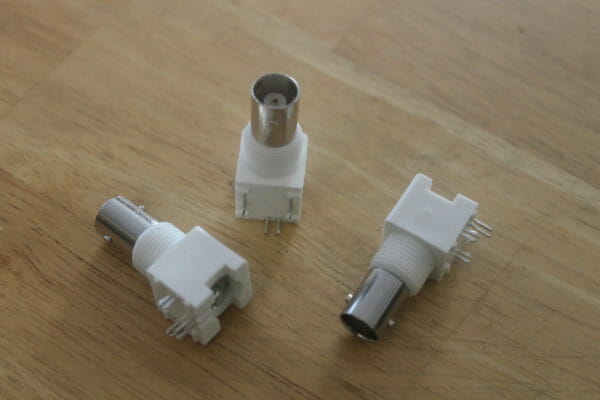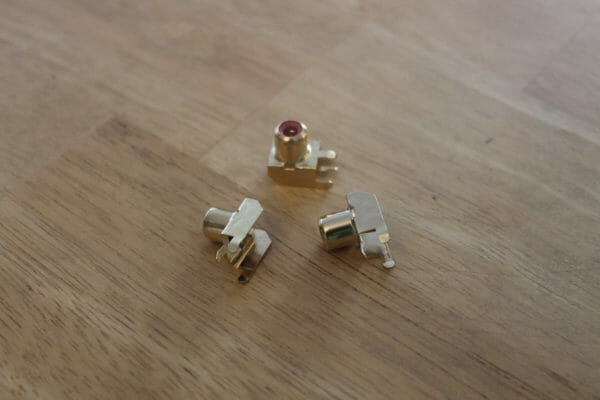Which is best for QRP Antenna Connectors: BNC or RCA? I’ve seen both on the web, so I’m trying to decide which connector to use for a QRP antenna. Maybe you can help me out: Which is the “best” (most common, most useful, works best) for a QRP Antenna Connector: BNC (which stands for “Bayonet Neill-Concelman” according to Wikipedia) or RCA “phono” connectors (they were used for connecting a turntable to an audio amplifier for something like a half a century)?

BNC connectors cost more but won’t come loose. RF cables with BNC connectors seem to be more available. What I didn’t realize until recently is that they come in both 75 Ω and 50 Ω types. My picture above seems to be of the 50 Ω type. Wikipedia has a side-by-side picture comparing the two types. The commercial version of the Buddipole uses them.

RCA connectors are inexpensive but can become unplugged. This can be an annoyance if you lose your connection when someone trips over the cable, or it can be a feature in that the antenna won’t get pulled over when someone trips over the cable
(Of course, any cables that are up over the ground, or any guy lines, should be marked with flagging tape — available from any hardware store — to prevent someone from tripping.)
Comments? Votes?
Thank you.
Aron, W1AKI


I forgot to add that the RCA connectors take up less space on the circuit board (whatever type it is) than the BNC connectors.
RCA connectors have limited frequency capability. This could be problematic for the higher HF bands. For this reason, I’d suggest using BNC connectors.
I bet RCA plugs would add a big impedance bump in the transmission line. I.e. they are shielded to avoid audio hum, and not to maintain constant impedance. Which is another way of saying essentially what Fred said.
One comment about BNC, though: Some can be hard to disconnect because you have to push the connectors together to release the tabs from the detent before you can twist them. This can be difficult when both connectors are not easily available, and can add both pressure and twisting torque to the PC-board mounted female connector (with the tabs). In my experience some connectors work much more easily than others. I’m not sure if this is by brand, by cheapness, or something else.
It’s a more complicated issue than either/or.
For QRP, BNC is certainly adequate from an electrical standpoint. However, there are a lot of BNC product families, whose characteristics, capabilities, and general quality vary greatly.
The impedance is pretty flat up to 1 GHz, at least for well-made MIL-spec versions.
There are two basic constructions of MIL-spec BNCs: the older ones in which the axial location of the center pin is determined only by the center conductor of the coax, and the newer captivated-contact types in which the contact is accurately positioned between a pair of dielectric parts. The former type can develop an inductive discontinuity at UHF, or if it backs out far enough, an open circuit.
The BNC family has an interfacial seal, but I learned the hard way that the coupling mechanism can rock laterally and let water leak in past the gasket. That causes corrosion of the coax braid, and high RF losses. If the installation will be outdoors, especially where salt spray is possible, such as the seaside or the bottom of a road vehicle, TNC or Type N would be a better choice, according to what an Amphenol applications engineer told me when I ran into trouble.
Then there’s the attachment arrangement. The MIL-spec versions connect to the cable outer conductor with an axial clamp and a rear peripheral seal, which gives some strain relief. A lot of commercial BNCs use a hex crimp sleeve, which is electrically secure and less dependent on the assembler’s skill, but doesn’t control the dimensional transition from the line to the connector body well, and can have an inductive discontinuity in the outer conductor that varies as the cable bends. (And it’s absolutely intolerant of incorrect crimp tools. Use ONLY the exact tool part number specified by the manufacturer.) Also, there is no strain relief in most crimp versions, so shrink tubing should be added to prevent a stress concentration during flexing. Obviously, these connectors aren’t watertight, so they’re suitable only for a dry environment such as the shack.
Coax connectors of any kind should only be bought from a reputable manufacturer qualified for MIL-spec products. Many of these parts from unknown sources, especially sources where the metric system prevails, are made to the nearest metric dimension and are out of tolerance mechanically, resulting in intermittents that are hard to locate. I’ve been burned by Chinese BNCs in my 10Base2 network.
RCA connectors, on the other hand, are probably electrically adequate for HF QRP. But, obviously, they’re not watertight, and are unsuitable for use outdoors. Strain-relieving them could be tricky.
It’s interesting to note that the RCA connector was introduced in the 1940s – by RCA obviously – so that components like a turntable could be connected to a radio. Prior to this, external components used the 1/4 inch plug to connect to a radio. I can remember being a little boy and hooking up the 45 turntable, with its RCA connector, to the radio to hear records. The RCA connector was designed primarily for audio equipment. I never thought they would be good for HF and anything else.
Aron, have you thought about using an SMA connection on the circuit board. They are wide band, DC to 26.5GHz, and at QRP levels there should not be a power problem.
Below is the Amphenol website on connectors.
https://www.amphenolrf.com/connectors/sma-connectors.html
73 Peter
Through 10m the performance difference between the two connectors would be difficult to measure.
I would still go with the BNC for the following reasons:
– Quality RF cables are readily available with BNC and nearly nonexistent with RCA.
– RF components, switches, attenuators, and test gear are commonly available with BNC.
– BNC connectors are secure and water tight.
– They work well to above UHF for future projects
I suggest baselining BNC. For the occasional “mint can” project use a RCA and have a couple of RCA to BNC adapters on hand.
73
@peter, no, I hadn’t thought of SMA connectors, so thank you. I already have some SMA pigtails and adaptors for my HT!
Everyone, thank you for your suggestions and comments!